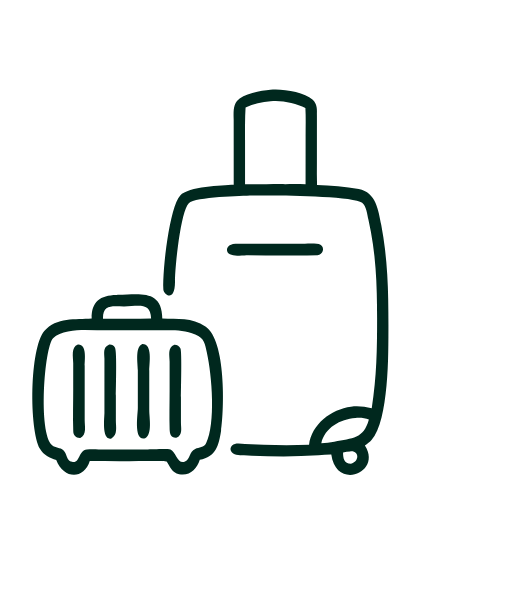Download the .pdf guide
Travel can be stressful, especially for some autistic & neurodivergent people. 
Whether traveling locally or long distance, it can feel unpredictable and overwhelming.
As with many difficult experiences, it’s important to both reduce overwhelming input and regulate overload, giving us more brain power to tackle difficult tasks.
General Travel Tips
Whatever way you plan to travel, have a plan!
- Prepare & Practice in Advance
-
Prepare before using unfamiliar modes of transportation to reduce stress
- Practice using the type of transportation during a low stress time
- See if someone else can come along the first time
- Plan your route, knowing the way is important even if you aren’t driving
- Have a map on hand, either on your phone or printed out
- Know details ahead of time: like bus stops, drop off spots, or parking
-
Have a contact number...
-
 Be ready with the contact information for where you are going if you are heading to a meeting or appointment, you may need directions on arrival, or if you are running late
Be ready with the contact information for where you are going if you are heading to a meeting or appointment, you may need directions on arrival, or if you are running late - Prepare for sensory needs
-
 Even sensory needs you may not expect at first. Public transport can involve a number of sensory concerns, it's best to be prepared.
Even sensory needs you may not expect at first. Public transport can involve a number of sensory concerns, it's best to be prepared. Examples: Ear plugs for sound, masks for smells, sunglasses for bright spaces
- Being on time
-
 Prepare to leave earlier then you think you need to to, and avoid a rush
Prepare to leave earlier then you think you need to to, and avoid a rushPlan to arrive 15 minutes early to prepare for delays or complications If you arrive early, have a plan where to wait Examples: A safe space or public spot nearby, shelter from cold or weather
- The unexpected can happen
-
If your ride is late or delays do happen...Have a backup way to travel, Examples: ride share app, someone to pick you up in an emergency
Remember: Travel can be complicated by things outside of your control. Buses can be late, construction can be happening. etc. It’s not your fault.
 The Bus
The Bus
Where available, public transport is a useful way to get around. It can feel very overwhelming to begin using public transport, but with preparation and experience, it can become a routine and less stressful experience.
-
Know your bus route and schedule ahead of time
-
- Find a schedule: Look online, on an app, or pick up a physical bus schedule from the bus itself

- Know where your bus stops are, and how to get to your destination from the nearest stop
- Plan alternate routes or options if a bus doesn’t arrive or is very late
- Find a schedule: Look online, on an app, or pick up a physical bus schedule from the bus itself
- Know how and when to pay for your ride
-
 Use Apps to make the process easier
Use Apps to make the process easier
- In Pittsburgh, the PRT app allows you to track the bus, purchase tickets, find routes/alternative routes.
- Many bus routes have similar services
- On the bus
-
- Know when to pull the cord to indicate you need to get off at the next stop
- Sit close towards the one of the exits to easily exit the bus, often the front of the bus front of the bus
- Be prepared for the bus to be crowded depending on time of day
 Using Ride Shares
Using Ride Shares
Ride shares can be a flexible option, even if they seem intimidating and may cost a little more.
- Know your options and how they work
-
 Common options include Lyft or Uber, but explore what other services might be available.
Common options include Lyft or Uber, but explore what other services might be available.- Explore these apps before you need them
- You will enter your destination in the app,
- Choose details, like the type of car you need
- Arrange a where the driver will pick you up
-
Trips can be scheduled in advance, even weeks beforehand
-
You will be given an estimate of travel time and cost when you schedule, but these can change during your trip
- Finding the Driver
-
If a driver is having hard time finding you, give them a tip.
Examples: Details about your location (such as an intersection or building near you), details about you (the clothes you are wearing).
Make sure you have all of your things before you leave the car
- Be Safe!
-
 Let others know where you are, ride sharing apps include “real time” and safety features
Let others know where you are, ride sharing apps include “real time” and safety featuresBefore getting in a car
- Check license plate and make sure it matches what is in the app
- Ask “Who are you here to pick up?” and wait for the driver to say your name before you share it with them
 Driving
Driving
Driving can involve intense sensory experiences, unpredictable situations, and social interactions that may make it especially difficult for those with autism.
There should be no shame in not having access to a vehicle or being unable to drive.
- Learning to Drive
-
Learning to drive can be scary, and can come with social pressure as well. Still, if you are in a situation where driving is an option, it may be more possible for you than you expect. It’s worth a try.
- Take your time and give yourself space. Try out driving in safe places, like parking lots, before you feel pressured onto the road
- If you need more time to learn than other’s expect, remember that it is more important to be safe!
- Everyday Driving
-
Prepare before you leave “park”.
- Know where you are going, have navigation ready or a route planned.
- Many navigation apps give you the option to avoid toll roads and highways if they are stressful
- Set up your phone to be hands free. It is also helpful to set up voice commands (Siri, Hey Google, or Alexa)
- Prepare things like music apps, messaging, or navigation.
Think about parking before you go. Options for this include checking the location Google maps, or calling your destination about options
In Pittsburgh, the GO mobile app can help you find parking.
- Check your dash for any issues, check engine lights, gas levels, etc.
- Make sure your sensory items on hand, like sunglasses
- Know where you are going, have navigation ready or a route planned.
 Airports & Plane Travel
Airports & Plane Travel
Flying , especially for those who haven’t done it before, can be confusing and full of unexpected complications.
Knowing what to expect and preparing for all the different aspects of your trip, including packing, the airport, security, and the flight itself, can help with this process.
- Before you go: Websites
-
TSA.gov includes rules and lists of what you can bring
TSA Instagram (Instagram.com/TSA) is responsive and can direct message them on Instagram to ask if things are ok to bring.
PortlyPassengers.com for information about the different rules Airlines have on body size and seating.
- Before you go: Sensory Needs
-
Sensory experiences on planes can be intense and inescapable. It is important to be prepared for these.
 Examples include...
Examples include...- Cabin pressurization can cause ear pain
- Nausea is a common experience
- Loud engine noise, and noisy passengers are common
- Due to seating, you may be in physical contact with others, or in a tight space
Prepare your sensory items and keep them on hand
 Earplugs and headphones can help with pressure and noise, and chewing gum can help with ear pressure
Earplugs and headphones can help with pressure and noise, and chewing gum can help with ear pressure- Wear comfortable clothing and consider items like neck pillows
- If you get nauseous, take medication in advance
- Bring stim items, but try to mindful of other passengers and choose items that don’t make sound or require large movements
- Baggage
-
Check baggage restrictions in advance, as these vary per airline.

- These include bag weight limits. You can weigh in advance
-
This also includes limits on sizes and type of other items (like no liquids above 3.4 ounces in carry-on, no lithium batteries, etc)
Use the airline app and check in for both yourself and baggage
Baggage Packing Tips
- Go through a day of your normal life, thinking about what items you use so you make sure to pack everything that you need.
- Think about different places you might go on vacation and items specific to those places. For example, at the beach you'd need sunscreen, bathing suits, sunglasses, hats, swim shirts, flipflops, etc..
- Remember: if you don't use it normally, you probably won't use it on vacation (you probably don't need three pairs of shoes if at home you only wear one).
- Pack larger items first.
- Clothes can be rolled up and placed in the gaps.
- Socks can be placed inside of shoes.
- Remember there are outside pockets in suitcases that can be used too.
- Carry-on Luggage
-
Check Carry-on restrictions in advance, like size, as these also vary per airline.

When Packing a carry-on, think about all of the things you'd need on the plane..
- Masks, sanitizer, or disinfecting wipes
- Sensory items like headphones, ear plugs, or sunglasses
- Jackets, carryon pillows, or blankets
- Food (be aware of limits)
- Medications you may need during the flight
- Items like blankets, sweatshirt, or purses needs to be put inside your primary bag
Tip: gum can help reduce for pressure changes in ears
Sometimes, they may gate check your baggage- you will pick it up on at plane exit or baggage claim
- The Airport and Security
-
Ask about disability accommodations.

- Mobility services can be available if you need them
- Some airports (including Pittsburgh) have a sensory room that may make it easier to cope with the busy airport environment
Security and TSA
- You can get randomly selected for screening and you didn’t do anything wrong
- There is a possibility of being scanned or touched
- This process is unpredictable on purpose – it changes over time
